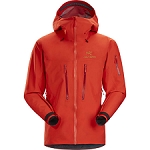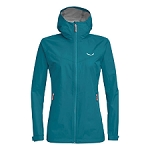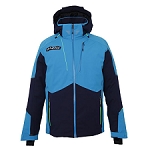Outer layers such as Gore-Tex shells are essential outdoor gear. In this guide we’ll go over the different types of outer layers available and how to choose the right one for every occasion.

When an outer layer becomes necessary. Photo: Ignacio Ferrando
Waterproof, breathable outer layers are a fundamental element of the outdoor layering system.
Every layer is important, and we recommend you take a look at these other articles, too.
In this article we’ll explain the different types of outer layers available in the market, their different uses, and which type is better for which conditions. If you’d like to know more about how these waterproof, breathable outer layers work, we recommend you take a look at this article from our site:
It’s a technical article, but worth the read, in which we explain the differences between two- and three- layer jackets, different membranes (such as Futurelight, Gore-tex, Pertex, or eVent), their pros and cons, and other technical considerations that will help you better understand how these breathable garments work.
Overview of the Outdoor Layering System
For outdoor activities, you are going to need protection from the elements, especially when conditions get poor (cold temperatures, wind, rain or snow). When conditions are bad, you’ll need help staying warm and dry. This means not only keeping the rain or snow out, but also proper ventilation from inside to evacuate moisture from your body.
As a solution to this problem, the three-layer system was developed.
- A waterproof, breathable outer layer whose purpose is to keep the wind and the rain out, while also allowing body moisture to be ventilated out.
- A mid layer whose purpose is to retain body heat
- And a base layer next to the skin, which is there to wick sweat away from the body and, in cold conditions, also helps the mid layer with retaining body heat.
However, as we’ll see the system can change, not only due to the multiple combinations it allows, but also because of innovations in outdoor technology over the years. Before getting into the types and uses of outer layers (or “shells”), we’re going to take a look at what’s referred to as the 2.5-3 layering system.
Evolution of the Outer Layer
Good base and mid layers are useless if, in poor weather conditions, the rain or snow gets in and makes us cold and damp, which can lead to serious problems.
This is why the outer layer is so important—its role becomes especially necessary when the conditions get particularly bad.
That is to say, we will always need to have a traditional, waterproof, windproof, and breathable outer layer. Until not long ago, this was the only type of clothing that existed to protect us at all times in the layering system. But that forced us to use these jackets or pants at times when we did not need as much protection, and then we were penalized for their lower breathability.
With time the system has evolved and new technology has appeared in the market. As we explained in the article about mid layers, nowadays we can talk about a 2.5 / 3 layer system, which has freed up the traditional outer layer from some of its function.
What is the 2.5 Layer System?
Basically, the base layer is the same, but the classic thick mid layers have now been split into two:
- A thin first one, supplemented by a micro-fleece or power-stretch jacket
- And mid / outer later, which can be a thin, insulated layer, which we’ll call “layer 2.5.” This layer provides warmth and protects against the wind, but also permits freedom of movement and is breathable.
These can be heavier or less heavy depending on the situation—going from thin options for aerobic activities such as ski touring, to other heavier models for less aerobic activities such as mountaineering or hiking.
With this system, the full outer layer is then often only used with rain, snow or extreme cold or wind, as the modified mid layer provides us with protection against the elements.

Rab Cirrus Flex Jacket, a mid/outer layer with synthetic insulation
This evolution started with softshell jackets—an outer / mid layer, with more protection than traditional shells, which are not insulated. A single jacket that combines the heat retention of a mid layer with some of the waterproof capabilities of a shell, in addition to being more elastic and more comfortable.

Climbing with a mid/outer layer on a cold, dry day. Photo: Daniel Vega
Types of Outer Layers
1. Hardshell
These are the traditional waterproof, windbreaker jackets with a Gore-Tex, FutureLight or similar membrane. These continue to be essential and can’t be beat when conditions are at their worst.
All of them have some common characteristics (highly water resistant with taped seams, breathable, and wind resistant). However, depending on their intended use we can find some that are ultralight (for intense aerobic activities without danger of abrasion on rock or other surfaces) as well as others that are more heavy duty in order to stand up to punishment during rock climbing or mountaineering. It all depends on the materials used to laminate the waterproof membrane.
For example, trail running jackets with Gore-tex Shakedry are so lightweight that they can’t be used with a pack, which can ruin them as they rub against the pack’s straps. On the other end of the spectrum are heavy-duty, reinforced jackets that will stand up to punishing activity for years.

The North Face Impendor Futurelight Jacket
2. Softshell
Softshells were the first step toward opening up the possibilities within the layering system. They’re a mix between the mid and outer layers. In fact, some of the winter softshells have the same design as a standard hardshell. Softshells are a great option when you need a combination of warmth, breathability and freedom of movement, and not expecting heavy rain. They’re water resistant to a point, but not nearly as waterproof as a hardshell. Softshells are typically more resistant to abrasion than hardshells.

Arc'teryx Gamma Lt Hoody, protective softshell
Another option are jackets that are designed more like a traditional mid layer, with or without a hood.

Trangoworld Raga TW86 Jacket, softshell windbreaker with lots of protection
Although it’s true that the combination of a thin fleece / warm mid layer has become more popular, they are still useful for situations where you need a hard-wearing and/or wind-resistant jacket, but not 100% waterproof.
All of this refers to harsh winter conditions, but where softshells really shine is in non-winter conditions where we need some protection against the elements, as well as a jacket that will take a beating.
For example: rock climbing: a garment when we don’t need winter-like protection, that’s breathable and abrasion resistant. They are also essential for mountaineering and three-season hiking, when we need something warm that does not overheat us. In addition, being water resistant, they will withstand light rain for a period of time. And they also work well as a layer in conditions worse than three seasons.

Outdoor Research Ferrosi Jacket, three-season softshell perfect for climbing, trekking or hiking
3. Hybrid Shells
The most exposed areas (shoulders, etc.) are done in hardshell materials, and the least exposed in softshell materials. This provides enhanced protection in bad conditions while also affording the comfort, breathability and abrasion resistance of a softshell.

Arcteryx Beta SL Hybrid Jacket. With Gore-tex Paclite, Gore-tex Pro and Gore-tex C-knit
4. Ultralight Jackets
Breathable, waterproof jackets with a Gore-tex Paclite or similar membrane, laminated in thin, lightweight fabrics. Ultralights first appeared as a complement to softshells, which you could put on over your softshell if the weather turned bad. These jackets are lightweight and barely take up space in your pack. In addition, they are a superior alternative to the traditional plastic summer rain slicker, which does not breathe at all, and also a great option for highly aerobic activities and modern fact-paced mountaineering.
In fact nowadays, high-quality outer layers made with Gore-Tex Pro or similar, can be nearly as lightweight as a more classic ultralight jacket, with the bonus of additional protection. An ultralight can weigh around 300g., and we can find Gore-text Pro jackets for around 400g.

Rab Meridian Jacket W, women’s ultralight jacket with Gore-tex Paclite
5. Insulated
In the traditional layering system, heat retention is doe by the mid layer. If we use insulated outer layers, we lose some of the versatility of the system by combining the protective outer layer and the warm layer in one. The use of an insulated outer layer isn’t recommended for outdoor activities, except in extreme conditions (winter arctic, expeditions, etc.).
On the other hand, insulated outer layers (whether softshell or hardshell), are quite popular for downhill / alpine skiing, where the aerobic activity of the runs is broken up by long periods of inactivity (while riding up the lift, for example).
Be sure not to confuse this type of jacket with the mid layers of the 2.5-layer system. Here we are talking about waterproof, breathable outer layers, with both a waterproof membrane and insulation.

Descente Jurgen Insulated Ski Jacket
Which outer layer is right for me?
It depends on the use and conditions.
The first thing to take into account is the cut you’re looking for. There are more athletically cut designs for mountaineering, which are harness compatible (usually shorter and with the side pockets repositioned). There are other models that are longer, with a less tailored cut, and more versatile (they are often harness compatible as well). And finally there are more simple models, designed for moderate hiking and mountaineering.
All technical jackets and some of the more versatile ones have oversized hoods that allow you to wear a helmet underneath. If you think you’ll need to wear your jacket with a helmet some day, be sure to check the compatibility.
A general recommendation is to go with a versatile model that’s harness compatible, but without going to the extreme of lightweight minimalism found in the most technical jackets. This will work for most activities and, with a straighter, less tailored fit, it will allow us to fit thicker layers underneath.
- For winter alpine activities, you’ll generally need a traditional hardshell that keeps you protected from the elements and you can combine with layers underneath. You can also try the 2.5 layer sytem, with an insulated softshell, if the conditions are right, taking a waterproof shell along in your pack in case the weather gets bad.
- If you are doing more aerobic activities such as ski touring, you can go for a 2.5 layer system, with a technical lightweight jacket, and again a waterproof shell in your pack just in case.
- For summer mountaineering, a lightweight shell is sufficient, made of a high-quality outer shell with lightweight materials. A three-layer Gore-Tex Pro jacket, for example, is ideal – lightweight for all-year use and heavy-duty protection for alpine activities.
- For situations where you’re looking for something that’s resistant to abrasion, breathable, comfortable and with protection against the elements when conditions aren’t too extreme, go for a softshell. And if you bring along an ultralight hardshell in your pack, you’ll be prepared for any eventuality.
Lower Body
Just like your upper body, your lower body also needs protection from the elements. However, there are some differences:
- Your legs don’t require as much protection as the rest of your body
- Freedom of movement is key
In cold, winter alpine conditions you’ll normally need a comfortable softshell pant (such as the well-known “Schoeller” pant, named for the fabric used in it), which can be combined with thermal tights and a waterproof overpant, which we can wear the entire time or carry just in case the conditions get extremely wet. Softshell pants are water resistant and unless there is heavy precipitation, the overpant generally won’t be necessary.

Millet Pierra Ment Pant W, women’s softshell ski touring pant
There are also hybrid pants—a softshell with full hardshell materials in strategic areas, such as the rear and the front of the legs.
In non-winter conditions, a pair of hiking pants or thin softshell mountaineering pants will be enough, with an ultralight overpant in your pack in case of poor weather.

Ternua Bihar Pant, men’s thin softshell pant

Rab Downpour Pants W, women’s ultralight waterproof pant, under 200g.
If you’re going to use outer shell pant, make sure it has a side zipper opening, to facilitate putting on and taking off your boots and/or crampons.


























Leave a comment
Be the first to comment on this article.